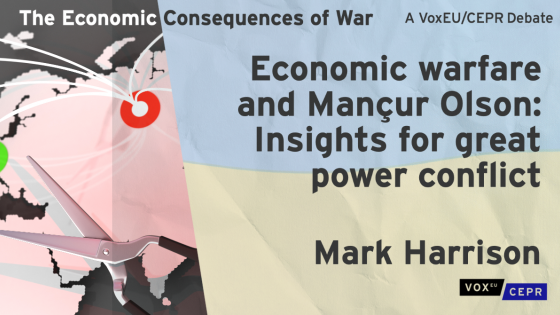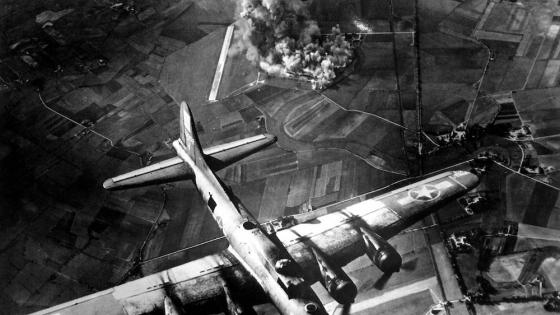Editors' note: This column is part of the Vox debate on the economic consequences of war.
Mançur Olson (1932-1998) is best known for contributions to the political economy of collective action (Olson 1965) and of comparative economic development (Olson 1982, 2000). In earlier work, Olson also provided novel insights into the economic adaptation of countries to international conflict.
When one country imposed trade sanctions on another, blockaded its food supply, or bombed its war industries, why did the results so often disappoint or surprise? This question puzzled and frustrated civilian and military leaders on both sides in two world wars.
The same question is of immediate relevance today in the context of Russian aggression against Ukraine. It is raised by several aspects of the conflict. Why did the Western threat of severe economic sanctions fail to deter Russia from planning and initiating an aggressive war? Related to this, what are the prospects for further sanctions to curb Russia’s aggression and bring it to an end? And at what cost to the West?
Bombing Germany
The possibility of economic warfare arose when a country’s economy was fully employed in the supply of war. The strategy of economic warfare was to weaken an adversary’s fighting power by attacking it, not directly, but through its supply chain. The tactics of economic warfare then aimed to block or destroy supplies of the commodities thought to be essential to the enemy’s war production or its war economy more generally. It was a tactical success if ships were sunk or factories were destroyed. But strategic success was achieved only if the enemy’s fighting power was weakened as a result. Given tactical success, would strategic success follow? Olson (1962) argued that the link from tactics to strategy would generally be undermined by the adversary’s adaptation. The key to this response, he suggested, was substitution.
Allied economic analysis indicated that ball and roller bearings were “essential” to the supply chain of German munitions (Bollard 2019). From August to October 1943 the US Army Air Forces systemically attacked and largely destroyed the small number of factories around Schweinfurt that provided around half of Germany’s ball-bearing capacity. While the cost in aircraft and crew was heavy, the observed effect on German war production was near zero (United States Strategic Bombing Survey 1946).
Olson noted several reasons. A high proportion of Germany’s existing supply of ball-bearings was used unnecessarily, where plain bearings would also do. Plain bearings were easily substituted when the supply of ball-bearings failed, so that the much smaller range of truly essential uses could still be met. In addition, to assure the essential uses, capital and labour were quickly diverted from other employments to rebuild the essential capacity in dispersed, less vulnerable locations. Thus, the German economy under attack was re-optimised for war by sliding along its production frontier, although at a cost to other less-important objectives.
This led Olson to be critical of model-based approaches to target selection (such as Wassily Leontief’s input-output framework) that assumed fixed coefficients in production and consumption. Such models implied that to deprive an economy of a single “essential” commodity, whether ball-bearings, oil, or molybdenum, would be a crippling blow. But this followed entirely from ruling out substitution, which turned out to be crucial to the outcome.
Starving Britain
In The Economics of the Wartime Shortage, Olson (1963) generalised his idea. He asked how Great Britain, most dependent of all nations on international trade, survived three major conflicts – the Napoleonic War and two world wars – without famine. Olson noted that food was widely thought of as an “essential” good and that, in all countries, food security loomed large in thinking about war preparations. This was the thinking of German leaders in two world wars when they applied submarine warfare to the blockade of the British Isles, aiming to cut the UK economy off from its main sources of food.
Olson rejected the idea that, in an integrated market economy, any one commodity, even food, was more essential than any other. At the margin, where choices must be made, the strategic value of a dollar’s worth of food would always be about the same as a dollar’s worth of anything else. In a rich society, food would have many uses, some essential and some inessential or luxurious. “It is not the type of good,” Olson wrote (1963), “but the type of use that distinguishes a necessity from a luxury” (my emphasis).
Before WWII, Britain imported more than three quarters of wheat and flour, oils and fats, butter, cheese, and sugar (Hammond 1951). The Battle of the Atlantic was hard fought and very costly to both sides. By 1942, as Table 1 shows, food imports were running at just half the rate of the first nine months (October 1939 to June 1940). The loss of imports was only partly mitigated by a substantial increase in home production. Yet, after a dip at the end of 1939, British food stocks never fell below the pre-war level.
Table 1 British food supplies and consumption in WWII
Sources: Food imports and stocks are from Hancock and Gowing (1949); home production and energy consumed from Hammond (1951).
Notes: The figure for food imports under 1939 covers October 1939 to June 1940, and that for 1940 covers July to December 1940. The figures for pre-war home production are averaged over 1936-1938. The figure for pre-war food stocks is from the end of August 1939.
Most importantly, Table 1 shows, the calories consumed per person remained essentially constant throughout the war, while their distribution was probably somewhat equalised by rationing. Rationing covered ‘luxury’ foods, but bread and potatoes were the most important sources of calories. These were never rationed, which also speaks to the adequacy of the food supply (Hammond 1951). As for health, in 1942 deaths among children and adult civilians fell below the rates of 1939 and continued along the pre-war downward trend (Titmuss 1950).
Thus, Britain survived blockade despite initially relying on foreign sources for nearly two thirds of calories for human consumption. Other countries that entered the war nearly or entirely self-sufficient struggled and sometimes failed to feed their populations. They failed because they were poorer, and so had fewer inessential uses of food at the outset, or because their economies were insufficiently integrated, so that efficient substitutions did not take place – or both.
The role of substitution
Economic warfare (or sanctions in peacetime) attempts to change the adversary’s behaviour by manipulating its costs. The power of the incentives involved are often overstated. The reason, Olson showed, is that the cost that the adversary actually pays for losing access to some external resource or facility is not the sudden stop of all the activities related to what has been denied but the cost of adaptation, which will generally be less.
It is tempting to swing the other way and conclude that economic warfare was pointless or had no effect on the outcome of the war. Olson (1962) took pains to reject this conclusion. He emphasised that supply-chain disruption was ineffective mainly when the economy was wealthy (so any commodity had many inessential uses) and when the commodity concerned was only partly interrupted (so enough remained for essential uses). He maintained that substitution had its limits. As an example of when those limits were breached, he gave the German synthetic oil industry in 1944–45. Germany had no natural oil reserves, and the pre-war creation of a synthetic oil industry was itself a substitute for a commodity in short supply. Access to Romania’s oilfields was lost in August 1944, making Germany entirely dependent on domestic sources. Repeated bombing of the oil plants in the summer of 1944 permanently reduced supply below consumption. By the time of the Ardennes offensive of December 1944, German plans relied on capturing Allied fuel stocks for their success (United States Strategic Bombing Survey 1946).1
Economic sanctions in context
For more than a century, great powers facing war have looked for the magic bullet that would collapse the adversary’s economy in weeks without spilling blood (Lambert 2012). The magic bullet was ‘found’ more than once in food sanctions, oil sanctions, credit sanctions, and so forth. Every time, it disappointed. International relations since 1945 have provided many cases of economic sanctions aimed at forcing states to change their behaviour without bloodshed, most of them apparently unsuccessful. “In cases involving core national interests, economic pain rarely translates into political gain” (Oegg and Elliott 2008; see also Jones 2015). Sanctions were likely to succeed only when stakes were low or when military disparities were very large.
Too often, our public policy discourse suggests that economic measures can take the place of defence and deterrence, enabling us to have our way in international disputes without putting lives at risk. The history of great-power conflict in the twentieth century suggests that this is incorrect. Economic warfare is a phase of war, not an alternative to it. Economic power complements military power in the sense that military pressure raises the effectiveness of denial of resources to the adversary – and conversely (Harrison 2020).
Complementarity between economic and military pressure is also found in cases where sanctions or the threat of them were not accompanied by credible deterrence. In 1940, fearing the blockade that the Allies had imposed on Germany in WWI, Hitler brought forward his plan to seize the farmlands and oilfields of the Soviet Union, carrying it out in 1941. Also in 1940, seeking to curb Japan’s war of aggression in China, the Roosevelt administration imposed oil sanctions. Fearing the costs to Japan’s economy and war effort, the Japanese leaders decided to preempt them by knocking out the US Pacific Fleet at Pearl Harbor in 1941. In both cases, the fear of blockade triggered a wider conflict.
More generally, the effect of economic measures on the adversary’s military power is indirect and slow. Indirect, because it runs through the economy; slow, relative to the speed of military action. Therefore, the more severe are the economic measures that a country faces, the more likely it is to find that its best response lies in violent escalation, despite the gamble involved.
The fact that economic measures have their effects indirectly, if at all, has implications for civilian support for aggressive policies. Economic warfare affects the enemy’s fighting power indirectly, via the economy. ‘Collateral’ damage to civilian lives and property is inevitable, and will be greater, the more the government works to shield the supply chain of war. As civilian losses mount, whom will civilians blame – their own government or the adversary? The question is vital. If most civilians blame the enemy, they will be more willing to tighten belts and make do with substitutes that would be unacceptable in peacetime. If most become disaffected from their own government, the opposite can be expected.
The net effect of sanctions on the morale of the targeted population is an empirical question. Historians have tended to suppose that the heavy collateral damage done by the bombing campaigns of WWII stiffened resistance, at first in Britain, and later in Germany. In recent work, by contrast, Adena et al. (2020) find evidence that German civilian and military morale was weakened, not strengthened by Allied bombing.
Applications to Russia’s war on Ukraine
This approach to economic warfare has three major implications for understanding the present widening of Russia’s conflict with Ukraine. First, why did NATO fail to deter or limit Russian aggression? Given the underlying complementarity of economic and military power, efforts to manage Russian behaviour should have balanced the threat or use of severe economic sanctions by increased investments in conventional and nuclear deterrence. In fact, the sanctions imposed on Russia after the first invasion of Ukraine in 2014 were not particularly stringent. The average effects on electoral support for the Putin regime may have been counterproductive (Peeva 2019). Meanwhile, NATO members have done little to bolster military defences or uphold the credibility of military deterrence. NATO itself has often appeared disunited. Signalling to Russia that NATO is economically strong but militarily weak has invited Russia leaders to play to their strength (Harrison 2015).
Second, the sanctions imposed on Russia since the widening of the war have escalated more rapidly than Russian leaders can have expected, but their effects will take time. The more severe is the expected economic damage to Russia, the lower will be the option value to the Putin administration of maintaining their present course. Instead, Russian leaders may respond by further escalation of violence, with the aim of crushing Ukrainian and NATO resistance before sanctions can have their full effect. This is not an argument against sanctions. It is an argument for economists to widen their horizons when carrying out backward induction. The adversary’s best response to an economic measure might be a military one, not just an economic one. In this setting, it is essential to enhance NATO’s military readiness and the credibility of Western deterrence to match the severity of the economic measures.
Third, the solidarity of Western civil society cannot be taken for granted. If Western Europe is to wean itself of Russian energy, the burden will fall first on the main consumers, Germany and Italy. With unchanged behaviour, large energy price increases have the potential to pit country against country and poor against rich. Will the losers put the blame on Russia, or on their own governments? This seems likely to depend on both the transparency of the measures and the compensations for those who would otherwise lose (as proposed by Chaney et al. 2022).
At the same time Olson reminds us that the burden to Western consumers will be less than appears at first sight. The preliminary working of Bachmann et al. (2022) has put the cost to Germany of a sudden stop of Russian energy imports at between 0.5% and 3% of GDP: a sum that they describe as “substantial but manageable” – and less than the cost of the pandemic so far. Calculations by Chepeliev et al. (2022) come up with still lower figures across the EU as a whole, and they also point to beneficial environmental spillovers. While such estimates can only be the beginning, they suggest grounds for optimism.
References
Adena, M, R Enikolopov, M Petrova and H-J Voth (2020), “The sword and the word: How Allied bombing and propaganda undermined German morale during WWII”, VoxEU.org, 19 November.
Bachmann, R, D Baqaee, C Bayer, M Kuhn, A Löschel, B Moll, A Peichl, K Pittel and M Schularick (2022), “What if? The economic effects for Germany of a stop of energy imports from Russia”, EconPol Policy Report 36, ifo Institute, Munich.
Chepeliev, M, T Hertel and D van der Mensbrugghe (2022), “Cutting Russia’s fossil fuel exports: Short-term pain for long-term gain”, VoxEU.org, 9 March.
Chaney, E, C Gollier, T Philippon and R Portes (2022), “Economics and politics of measures to stop financing Russian aggression against Ukraine”, VoxEU.org, 22 March.
Bollard, A (2019), Economists at war: how a handful of economists helped to win and lose the World Wars, 1935-55, Oxford University Press.
Hammond, R J (1951), Food, vol. 1. The Growth of Policy, London: HMSO, History of the Second World War: United Kingdom Civil Series.
Hancock, W K and M M Gowing (1949), British war economy, London: HMSO, History of the Second World War: United Kingdom Civil Series.
Harrison, M (2015), “Why sanctions are no alternative to defence”, Financial Times, 19 February.
Harrison, M (2021), “Oil and the great powers”, Journal of Strategic Studies.
Jones, L (2015), Societies under siege: exploring how international economic sanctions (do not) work, Oxford: Oxford University Press.
Lambert, N (2012), Planning Armageddon: British economic warfare and the First World War, Cambridge, MA: Harvard University Press.
Oegg, B and K Elliott (2008), “Russia and the effectiveness of economic sanctions between big players,” VoxEU.org, 8 October.
Olson, M (1962), “The economics of target selection for the Combined Bomber Offensive”, Royal United Services Institution Journal 107(628): 308-314.
Olson, M (1963), The economics of the wartime shortage: a history of British food supplies in the Napoleonic War and in World Wars I and II, Durham, NC: Duke University Press.
Olson, M (1965), The logic of collective action: public goods and the theory of groups, Cambridge, MA: Harvard University Press.
Olson, M (1982), The rise and decline of nations: economic growth, stagflation, and social rigidities, New Haven: Yale University Press.
Olson M (2000), Power and prosperity: outgrowing communist and capitalist dictatorships, Oxford: Oxford University Press.
Peeva, A (2019), “Did sanctions help Putin?” Discussion Papers 2019/7, Free University Berlin, School of Business & Economics.
Titmuss, R M (1950), Problems of social policy, London HMSO, History of the Second World War: United Kingdom Civil Series.
Toprani, A (2019), Oil and the great powers: Britain and Germany, 1914 to 1945, Oxford: Oxford University Press.
United States Strategic Bombing Survey (USSBS) (1946), Summary report (European war), Washington, DC: United States Government Printing Office.
Endnotes
1 A new view of the failure of both German and British plans for energy independence in WWII is provided by Toprani (2019) (reviewed in Harrison 2021).




